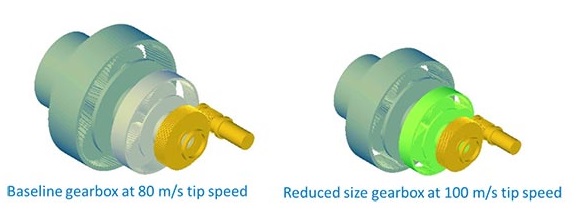NREL and Sandia recently published two reports on their collaborative effort to study the effects of increased maximum allowable blade tip velocities on overall system cost and performance. The maximum rotor rotation speed for utility-scale wind turbines is generally constricted by noise considerations. Even so, innovations in acoustics or siting in remote locations or both could let future wind turbine designs operate with higher tip speeds which may allow for reduced overall system cost.

Gearbox sizing for different speed ratio requirements driven by different maximum allowable tip speed constraints.
In the first study, Understanding the Benefits and Limitations of Increasing Maximum Rotor Tip Speed for Utility-Scale Wind Turbines, NREL and Sandia performed a sequential optimization of the turbine rotor, nacelle, and tower under two different tip velocity limits of 80 m/s and 100 m/s. In this study, Sandia used a detailed set of rotor models for the blade structural design [1]. The research team investigated the effect of tip-velocity constraints on system levelized cost of energy (LCOE). The results indicated that a change in maximum tip-velocity from 80 to 100 m/s could produce a 32% decrease in gearbox weight and a 33% reduction in gearbox cost. In the study, the significant reduction in gearbox weight due to the higher tip velocity and lower overall gear ratio was counterbalanced by increased weights for the rotor and/or other drivetrain components and tower. As a result, the increased costs of either the rotor or drivetrain components offset the overall reduction in turbine costs from down-sizing the gearbox. Overall, the team found several design trade-offs and design constraints that come into play when seeking to maximize the benefits of higher tip velocity constraints.
In the second study, Effect of Tip Velocity Constraints on the Optimized Design of a Wind Turbine, which was presented at the Science of Making Torque from Wind Conference in June, NREL used the new system tool, Wind-Plant Integrated System Design and Engineering Model (WISDEM), to perform a full integrated optimization of the turbine and plant for overall system cost of energy over a range of tip velocity limits and site conditions [2]. The research team developed a multidisciplinary, system-level framework to facilitate wind turbine and wind plant analysis and optimization where a global optimization was performed for overall LCOE. As expected, almost all of the cost savings could be attributed to the decrease in gearbox mass because of the reduced maximum rotor torque. Furthermore, the team discovered that extreme increases in tip speed were unnecessary. Benefits for maximum tip speeds greater than 100 to 110 m/s were small to nonexistent.
[1] Dykes, K.; Resor, B.; Platt, A.; Guo, Y.; Ning, A.; King, R.; Parsons, T.; Petch, D.; Veers, P. (2014). Effect of Tip-Speed Constraints on the Optimized Design of a Wind Turbine. 77 pp.; NREL Report No. TP-5000-61726. http://www.nrel.gov/docs/fy15osti/61726.pdf [2] Ning, A.; Dykes, K. (2014). Understanding the Benefits and Limitations of Increasing Maximum Rotor Tip Speed for Utility-Scale Wind Turbines. Article No. 012087. Journal of Physics: Conference Series. Vol. 524(1), 2014; 10 pp.; NREL Report No. JA-5000-61729. http://dx.doi.org/10.1088/1742-6596/524/1/012087Filed Under: Gearboxes, News




